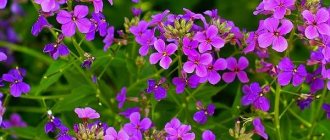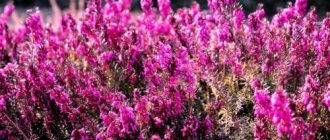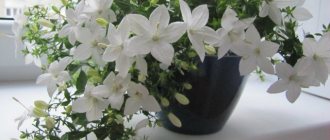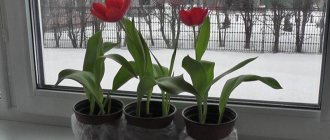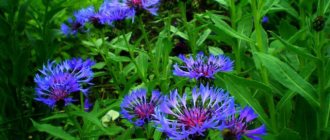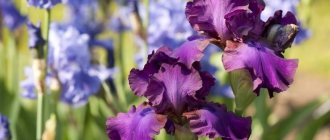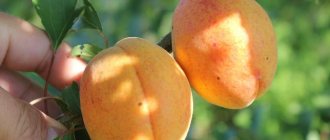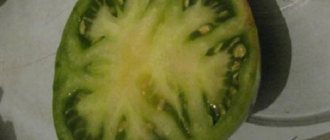Botanical description and homeland of the plant
Chinese Belamkanda (Belamcanda chinensis) is an ornamental species of the Belamkanda genus, belonging to the Iris family.
Externally, the plant resembles a cross between an iris and a lily: the rhizome and leaves are like the first, and the six-petaled flowers with touching stamens are similar to lilies. Fleshy roots lying in a horizontal plane are located close to the soil surface. The length of the wedge-shaped hard leaves is 35-50 cm.
When does belamkanda bloom?
Belamkanda chinese flower photo
Flowers bloom in late June and early July. The flowering period will last until mid-September. The corollas open in the first half of the day; at night they are twisted with a screw.
The flowering stem is a meter long, at its top there are about 20 corollas with a diameter of about 6 cm, the color is monochromatic or spotted. The color scheme is in yellow-brown, orange, pink tones, the shade of the spots is contrasting. Belamkanda is also called leopard flower, leopard lily, Chinese orchid.
Belamkanda fruits photo
After flowering, a large oblong seed capsule is formed. When it dries and opens, round black seeds, similar to berries, will become visible, but they should not be eaten.
Berries of belamkanda forest orchid photo
Perhaps belamkanda can be found in garden plots more often than in the wild. It grows in the Far East, East Asia, Malaysia, Indo-China and is protected by the Red Book.
It is preferable to grow in an open, warm area with moderately moist humus-rich soil. Belomkanda winters in open ground without shelter if the temperature does not drop below -15 °C. Can be cultivated at home.
Varieties with pink flower color
Variety Lambada
The lilac-pink lily was created by Russian breeders in 1993. The cup-shaped flowers pointing upward seem very delicate and attractive. The center of the flower has numerous dark purple speckles on a creamy white background. The inflorescence is loose, reaching up to 15 cm in diameter. Plant height is from 110 to 130 cm. Flowering begins at the end of June and lasts about two weeks. Propagated by bulbs. Used for landscaping and cutting.
Variety Ophelia
Lily Rosalie
Created in 1995. The soft pink inflorescences with specks of dark purple are captivating. On a high peduncle reaching up to 100 cm, 10-12 cup-shaped flowers, about 14 cm in diameter, open alternately. The color of the buds before opening is a beautiful lilac color. Blooms in the second decade of July. Good for early forcing, as well as for cutting and landscaping.
Variety Silt
Lily Silt has a pure, beautiful pink color without specks or streaks. The height of the plant reaches 100 cm. The diameter of the flower is from 15 -17 cm. At the base, the petals are lighter, relative to the curved edges. The flower is a classic star-shaped flower, wide open and growing upward and to the side. It has a delicate unobtrusive aroma. Frost resistance is excellent. Perfect for flower beds, single and group plantings. Ideal for cutting. A bouquet of lilies lasts a long time and pleases the eye.
Variety Rosalin
One of the new bright varieties. The lily is deep pink in color with a yellow center and white strokes in the center of the petals. A very elegant and charming variety. Plant height is up to 60 cm. Flower diameter is about 10 cm. Flowering is abundant, starting from mid-June. There is no aroma. It reproduces well and is very unpretentious.
Growing belamkanda chinensis from seeds
Belamkanda from seeds photo seedlings
Belamkanda is capable of self-sowing, but in the conditions of central Russia the seeds will simply freeze. It is better to collect them and store them in a cool, dark place; germination lasts for about 2 years.
You can achieve flowering in the first year by growing seedlings:
- Sow belamkanda seeds in March so that by the beginning of May the seedlings are ready for planting in open ground.
- Prepare a wide container with a mixture of sand and peat.
- Pre-soak the seeds overnight in warm water, then soak for about 10 minutes in a slightly pink solution of potassium permanganate, rinse, dry and plant into the soil to a depth of their own size, spray with a fine spray.
- We stimulate the seeds to germinate with cold: cover the container with film and keep it at an air temperature of 0 to +5 °C for 15 days.
- Then we return it to a warm room and place it under diffused light, remove the film after germination, water it moderately.
- Plant the seedlings in separate pots after a pair of true leaves appear.
Varieties with orange and apricot flower colors
Variety Caluroso
Asiatic lily up to 100 cm high. The stems are straight, green and densely leafy. The leaves are arranged in regular order. The flowers are collected in pyramidal inflorescences of bright orange color without strokes or specks. The number of buds is approximately 6. The flowers are directed upwards and to the sides. Frost resistance is excellent. The flower size is up to 18 cm in diameter. Use in group plantings, mixborders and for cutting. Blooms in the second half of June.
Apricot Fudge variety
Lily Apricot Fudge
This variety also belongs to the Asiatic lilies, but, unlike the previous ones, it looks especially exotic, with apricot-colored flowers and greenish stripes in the center of the petals, up to 30 inflorescences on one bush. This variety of lilies seems unusual because the shape of the flower is more reminiscent of a tulip or a rose in bud. The diameter of the flowers reaches 8 cm, the height is from 70 to 90 cm. The flowers do not open completely during the growing season. The variety is not too tall, but very attractive. Flowering in July, August. They have a weak but pleasant aroma.
Variety Linda
The flaming color of this lily will not leave anyone indifferent; it burns with flame in the sun’s rays, deliciously and attractively emphasizing the beauty of lush flowers. This is a medium-sized, two-color lily up to 90 cm in height. The flowers are large, up to 17 cm in diameter, consisting of 6 bright orange petals, fading to light gold towards the base. The foliage is deep green. Blooms in June or July. Prefers well-lit places, but can also grow in partial shade.
Planting and caring for belamkanda in open ground
Belamkanda chinensis in the garden photo
When and how to plant
Belamkanda is planted in open ground in the spring. Make a shallow planting hole slightly larger than the rhizome, place some coarse sand on the bottom and plant. Step back 15-20 cm from each plant.
How to water
Be careful with watering, as dampness causes the roots to begin to rot. The plant tolerates periods of drought better, but it should be watered from time to time; between procedures, let the soil surface dry out.
Feeding
Do not skimp on feeding belamkanda. Apply complex mineral fertilizers every 15 days, and during the flowering period the procedure can be weekly.
Pest and disease control
The only thing that threatens belamkands in garden culture is rot. This plant is afraid of the slightest waterlogging, which immediately leads to damage to the rhizome and the base of the shoots. Pests are not dangerous for domestic iris.
Home iris (Iris domestica), or Chinese Belamcanda (Belamcanda chinensis). © Laura Blanchard
Iris domestica reproduces quite easily. For this plant you can use:
- seed method;
- division of rhizomes.
You can divide mature, powerful belamkanda bushes both in spring and early autumn (as soon as flowering is completed). In each division you need to leave at least 2-3 shoots and a powerful bunch of roots. Belamkanda delenki are planted immediately in a permanent place, not forgetting to add the classic portion of organic fertilizers when planting.
Belamkanda seeds can be planted both in open soil in mid-autumn (the optimal time is October) and in the spring for seedlings. In the second option, in order for domestic iris seeds to germinate, they will need seed stratification for 1 month (it is best to do this after sowing, putting the containers in the refrigerator). The best time for sowing seedlings is February or March. For belamkanda, any loose and well-moistened substrate, warmth and bright light are suitable. As the soil dries, you need to water it carefully, and when the plants produce 2 true leaves, they need to be picked into separate containers. Seedlings can only be planted in open ground in May.
Caring for belamkanda at home
Belamkanda at home how to care
Leopard flower develops and blooms successfully when grown in a pot. Place it on a windowsill facing east or west, where the sun's scattered rays will fall on the plant. For planting, use a universal nutrient soil mixture, water moderately, and feed. In summer, you don’t have to plant them in the ground, but simply take them out into the fresh air (in the garden, on the balcony, on the veranda).
In winter, belamkanda goes into a dormant state: first of all, ensure a temperature range of 10-15 °C, stop feeding, and water extremely rarely.
Usage
Belamkanda is a very elegant and delicate plant that can get lost in a bright or dense flower garden. It is preferable to plant it in groups on rocky hills or in rock gardens, and also use it as bright spots on the lawn. Feels good on sunny slopes or in the vicinity of low-growing coniferous plants. Looks impressive in pots on the veranda, in the winter garden or on the balcony.
Twigs with fruits and dried translucent petals of the seed pod are used to decorate dry bouquets.
Belamkanda in landscape design
Belamkanda in the garden photo of flowers
The graceful belamkanda grows beautifully on an alpine hill, in a rock garden, or in a rocky garden. It can get lost in a massive flower bed; in this case, it is better to plant it in a group; you can also create a bright spot on the lawn.
Belamkanda in garden design photo
Leopard lily is also used to frame flower beds, ponds, and edges in the garden.
Suitable partners are monarda, astilbe, rudbeckia, heliopsis, coreopsis.
Reproduction
The indoor lily reproduces with the help of small bulbs extending from the mother.
Separating the children from the main bulb and planting them in separate pots is carried out in April - May. To do this you need:
- Fill the pot with a layer of drainage and soil;
- Place a small onion there to a depth of no more than 5 cm;
- Sprinkle with a thin layer of earth;
- Water a little.
Experts recommend planting several “babies” in one pot, then flowering will be more abundant and longer. You need to plant the bulbs very carefully, without damaging them.
Propagating a flower from seeds is a rather troublesome and time-consuming task. In this case, the lily develops very slowly and begins to bloom for the first time only 5 years after planting. Seed material that has expired will not sprout, so you should be careful when purchasing it.
Bulb transplantation
The soil should be completely renewed once a year. This stimulates the growth of the lily and is a good prevention of diseases, pests and parasites. Small children are separated from the large bulb and each placed in their own pot.
Every gardener should know how to plant lilies. To transplant, the bulbs are carefully dug up and cleared of soil, and the children are removed with a sharp knife. If the tuber begins to rot, the affected areas are cut off. Next, the bulbs are disinfected in a solution of potassium permanganate and dried, so that they can be planted in the spring. You can dry it on the windowsill by laying a newspaper or a piece of thick fabric there. Store planting material in a dry and dark place, in cotton bags.
Transplantation is the most important care event.
Belamkanda varieties: photos and names
Belamcanda yellow variety Belamcanda chinensis 'Hello Yellow' photo
Flava – has solid yellow flowers.
Belamkanda Chinese violet variety Paul Thomas photo
Purpurea is a shade of flowers ranging from pink to purple.
Belamkanda pink photo
Flabellata Gray - leafy rosette grows in a fan, yellow flowers.
Iris domestica and its leopard flowers
The plant, known to most gardeners under the name leopard lily, is scientifically more correctly called iris domestica. After all, the plant has long been included in the genus of irises and is grown in many respects according to the same laws as them. But still, the old name belamcanda is much closer to the hearts of gardeners around the world. Whatever you call this plant, its status as a garden exotic will not change. Belamkanda is a catchy and bright crop, daring, with unusual details and requiring an unusual approach to cultivation.
The species diversity of belamcanda is limited: only one species is grown in landscape design - Chinese belamcanda (old belamcanda chinesis and modern name iris domestica). This plant is listed in the Red Book and is endangered. But if natural belamkands are a rare sight, their popularity in garden culture is only growing. And we should hope that the charming culture will be fully appreciated here too, and not just in the West.
Domestic irises are today considered one of the most spectacular garden perennials among accents. They are valued primarily for their unusual long-lasting flowering, but belamkanda’s foliage is also very good. The height of this perennial is limited to 60-70 cm, although some species in nature can reach more than a meter in height. The peculiarity of belamkanda is that the leaves are located exclusively in the lower half of the stems, up to 8 pieces on one shoot. Half a meter or shorter, with a width of 2-4 cm, they resemble the shape of iris leaves, broadly xiphoid, quite light.
Luxurious belamkand flowers are collected in inflorescences of up to 20 “lilies” in each. Spreading, paniculate and branched panicles allow you to appreciate the beauty of each individual flower. But they are only generally similar to lilies, reaching 7 cm in diameter, very catchy and bright. “Petals” are oval, rounded. Widely open tubular flowers with 6 perianth lobes fused at the base are distinguished by their asymmetry: the inner lobes are shorter than the outer ones. The flower is decorated with only 3 stamens. Like daylilies, belamkanda flowers bloom for only one day, but this feature is almost invisible due to the ability to tirelessly form new buds. After flowering, the belamkand bears fruit-boxes about 3 cm long, with the thinnest membrane-walls.
In central Russia, as well as in regions with harsh winters in general, the flowering of belamkanda begins in June, most often towards the end of the month and ends in August.
The color palette of belamkanda is not limited to orange tones. The plant has both a yellow-flowered flava form and a variegated purpurea form. But the leopard lily always remains a flower of fire.
Iris domestica or Belamkanda chinese yellow-flowered flava form. Bruce Calvin
Belamkanda is used in ornamental gardening:
- to create spectacular spots on lawns;
- in the design of mixborders;
- as an exotic accent in flower beds;
- in the design of edges with spectacular ornamental shrubs and trees;
- in compositions with a focus on fiery scale;
- as a potted accent.
The healing properties of belamkanda
Belamkanda chinensis leopard flower
Traditional medicine uses a decoction of belamkanda rhizome, but an overdose causes poisoning. When taken carefully under the supervision of a doctor, the decoction relieves cough and reduces sore throat. It has an antibacterial, antifungal, antiviral, diuretic, laxative effect, and removes toxins from the body. Externally used for injuries, sprains, skin rashes.
Useful properties of lily flowers
Benefits of lily flowers:
- Analgesic effect
. Helps cope with pain in the eyes and burning after burns. To eliminate unpleasant symptoms, the petals are soaked for 8-10 hours in cold water and the infusion is used for lotions. - Sedative and calming
. The petals are brewed with boiling water and left for 30 minutes. Drink 2-3 teaspoons for increased agitation and tachycardia, and 2 tablespoons for trouble falling asleep. - Expectorant and mucolytic
. Fresh flower heads are ground in a blender and mixed with honey until smooth. 30-40 minutes before meals, dissolve 1 teaspoon under the tongue. With the help of this composition you can increase your immunity. Only lily honey is dissolved daily, a teaspoon on an empty stomach. - Regenerating and accelerating wound healing
. Flower heads are boiled for 1-2 minutes with milk, squeezed and filtered. Used for rinsing for stomatitis and pharyngitis, soaking gauze pads for burns or applying to rough scabs of wounds. - Antimicrobial and wound healing
. Flowers are infused with vodka for 2 months in a dark place. Can be used to treat acne with oily skin.
Lily pollen has a beneficial effect on the body. To collect, you have to process a large number of inflorescences, but the costs are justified. By dissolving the sweet substance, you can reduce blood pressure in case of hypertension, increase appetite and hemoglobin levels, and prevent acute respiratory viral infections during the epidemic season.
